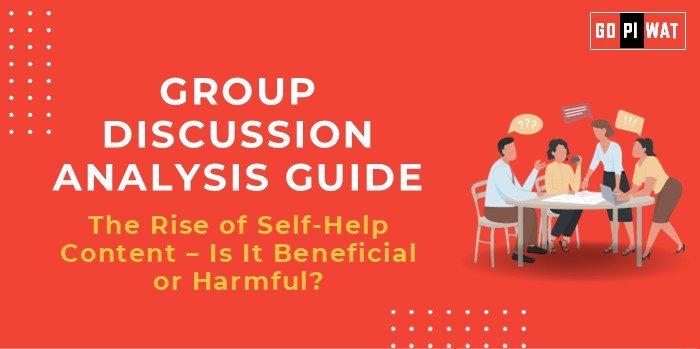📋 Group Discussion (GD) Analysis Guide
📚 The Rise of Self-Help Content – Is It Beneficial or Harmful?
🌟 Introduction to the Topic
- 💡 Opening Context: “With the exponential growth of self-help books, podcasts, and online content, this genre has evolved into a billion-dollar industry, promising solutions for personal and professional growth.”
- 📖 Topic Background: The self-help movement began as a niche genre but exploded with modern technology, enabling access through YouTube, Instagram, and audiobooks. Its increasing prevalence raises questions about its societal impact.
📊 Quick Facts and Key Statistics
- 💵 Market Size: The global self-help market was valued at $13.2 billion in 2022 and is expected to grow annually by 5.6%.
- 📱 Digital Reach: Over 70% of self-help consumers engage through digital platforms.
- 📖 Popularity: “Atomic Habits” sold over 10 million copies, showcasing enduring demand.
- 👥 User Demographics: Millennials are the largest consumers, citing stress management and career growth as primary motivations.
- ⚠️ Concerns: Over 40% of mental health professionals warn of unrealistic expectations set by self-help content.
👥 Stakeholders and Their Roles
- 🖊️ Content Creators: Authors, influencers, and trainers providing accessible solutions.
- 🙋♂️ Consumers: Individuals seeking growth or relief from stress.
- 📈 Publishers & Platforms: Amplify reach and monetize content.
- 🧠 Mental Health Experts: Offer professional perspectives, often contrasting self-help oversimplifications.
🏆 Achievements and ⚠️ Challenges
🏆 Achievements:
- 🌐 Accessibility: Encourages self-improvement globally at low costs.
- 📖 Diverse Formats: Audiobooks, apps, and workshops cater to various learning preferences.
- 🧠 Mental Health Awareness: Empowers individuals to seek help or develop resilience.
⚠️ Challenges:
- 💭 Unrealistic Claims: Promises of quick fixes can mislead consumers.
- 📉 Overgeneralization: Ignores individual complexities.
- 💵 Commercial Exploitation: Monetization often overshadows genuine guidance.
🌍 Global Comparisons
- 📚 Example: The popularity of “Atomic Habits” demonstrates global demand for actionable content.
- 🧠 Challenges: Critiques in oversimplification parallel debates across countries.
🛠️ Structured Arguments for Discussion
- ✅ Supporting Stance: “Self-help content democratizes personal growth, offering tools for emotional and professional success.”
- ❌ Opposing Stance: “Over-reliance on self-help material fosters toxic positivity and delays necessary professional intervention.”
- ⚖️ Balanced Perspective: “While self-help content empowers many, critical evaluation of its claims is crucial to avoid adverse effects.”
🎯 Effective Discussion Approaches
- 📊 Data-driven: “With $13 billion in annual revenue, the self-help industry touches millions of lives.”
- 🎭 Contrast: “While self-help content inspires, overdependence on it raises ethical concerns.”
- 🧩 Counter-Argument Handling:
“Critics argue that self-help oversimplifies issues, but it serves as a first step for those hesitant to seek formal therapy.”
📈 Strategic Analysis of Strengths and Weaknesses
- 💪 Strengths: Accessibility and affordability, wide reach through digital mediums.
- ⚠️ Weaknesses: Risk of misinformation or overgeneralization.
- ✨ Opportunities: Integration with mental health services.
- ⚡ Threats: Potential for exacerbating mental health issues without proper guidance.
🎓 Connecting with B-School Applications
- 💻 Real-World Applications: Business models for app development, digital marketing in wellness.
- 🎤 Sample Interview Questions:
- “Discuss the ethical challenges in monetizing self-help content.”
- “How can AI enhance personalized self-help experiences?”
- 💡 Insights for Students:
- Analyze consumer behavior trends in the self-help industry.
- Evaluate the role of self-help in leadership training.


